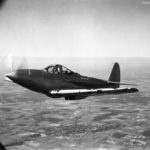The XFL-1 differed from the XP-39 primarily in having a tailwheel undercarriage
Bell XFL-1 Airabonita in flight 2
Bell XFL-1 July 1940
XFL-1 on the ground
XFL-1 front view
XFL-1 in flight
XFL color photo
XFL-1 Airabonita side view
XFL-1 in flight
XFL-1 front
XFL Airabonita was a US experimental fighter aircraft developed for the United States Navy by Bell Aircraft Corporation. It was similar to and a parallel development of the land-based P-39 Airacobra, differing mainly in the use of a tailwheel undercarriage in place of the P-39’s tricycle gear. Only single prototype was manufactured.
In 1938, the US Navy sought a new fighter plane to replace their outdated biplane fleet, resulting in various submissions from manufacturers such as Grumman, Vought-Sikorsky, and Bell. One contract, numbered 63629, was awarded to Bell on November 8th of that year for their proposed Model S design. This prototype, designated the XFL-1 Airabonita, was essentially a navalized version of the P-39 Airacobra then being developed for the Air Corps, albeit with several key differences.
Unlike its Army counterpart, the XFL-1 was designed with carrier operations in mind and featured a reinforced structure to withstand the rigors of carrier landings. The aircraft was powered by an 1,150hp Allison XV-1710-6 liquid-cooled engine with a Curtiss three-blade propeller, which was located aft of the pilot, and coolant radiators were situated under the wing. The aircraft also featured larger, three-section flaps to reduce stalling speed, and its vertical tail surfaces were modified to maintain longitudinal stability at high angles of incidence. Additionally, the XFL-1 had a conventional undercarriage with a tailwheel, and an arrester hook was added for carrier landings.
The cockpit was raised to improve visibility for the pilot, but the car-like doors from the P-39 were retained. To facilitate carrier landings, a small window was placed under the fuselage ahead of the wing root. The armament for the XFL-1 was to include two 0.3 inch Browning synchronized machine guns in the nose and a Browning 0.5 inch machine gun or 37mm cannon firing through the propeller hub, though these were never installed.
After making its first flight in May 1940, the prototype encountered issues with the Allison engine and balance, leading to delays in its delivery to the Navy. Testing officially began in July 1940, but undercarriage troubles prevented the aircraft from being certified for carrier operations. The XFL-1 was subsequently returned to Bell for modifications in December 1940, and the US Navy ultimately decided not to pursue production of the Airabonita in February 1941. The project was ultimately scrapped in favor of the Vought contender, which would later become the F4U Corsair.
The XFL-1 prototype was transferred to the Aircraft Armament Unit for anti-aircraft tests in February 1942 and was ultimately destroyed. Remnants of the aircraft could still be found in the mid-1960s at the dump of the Patuxent River Naval Air Test Center.









